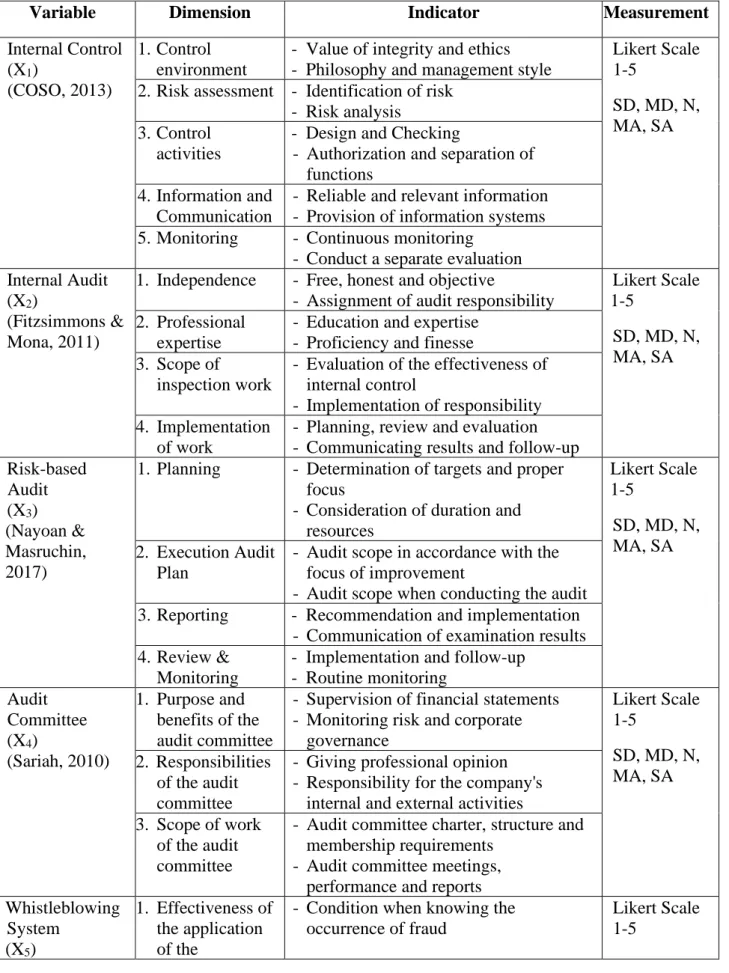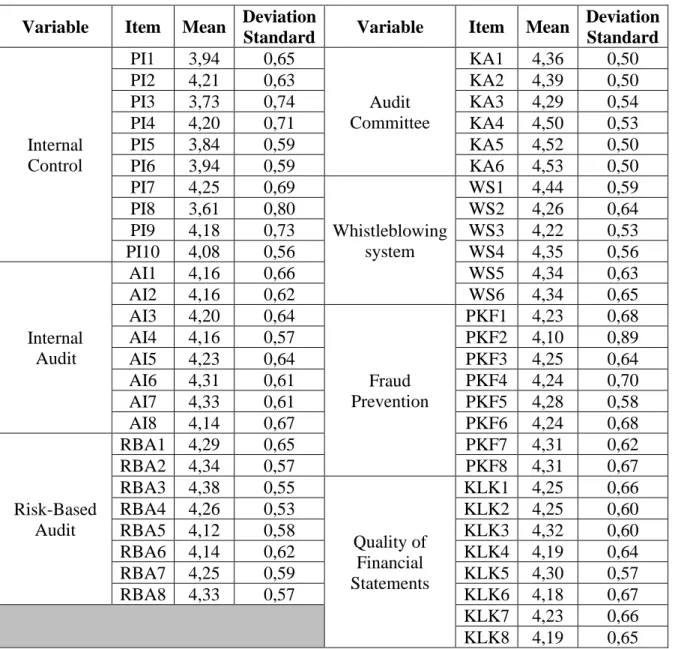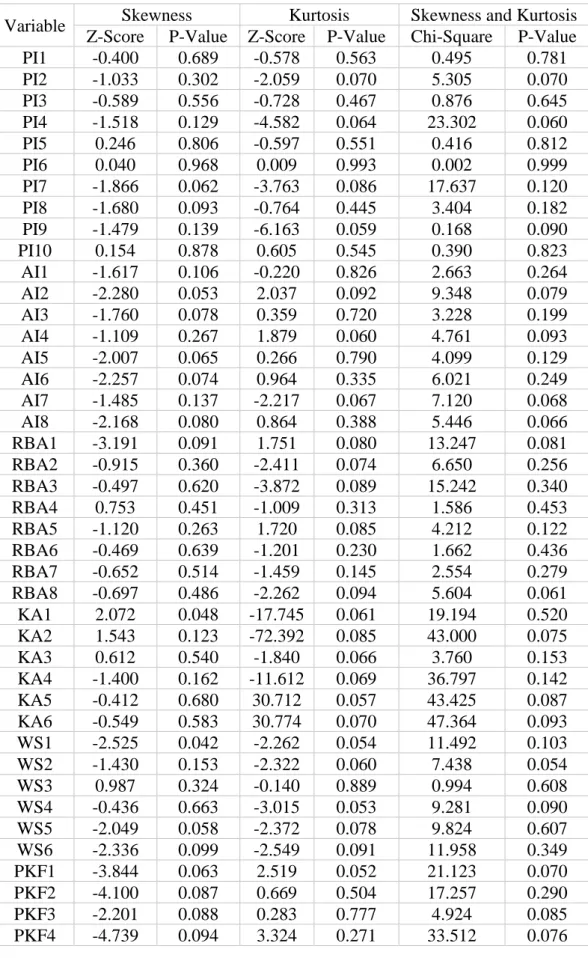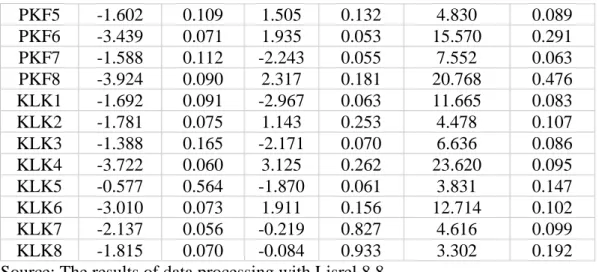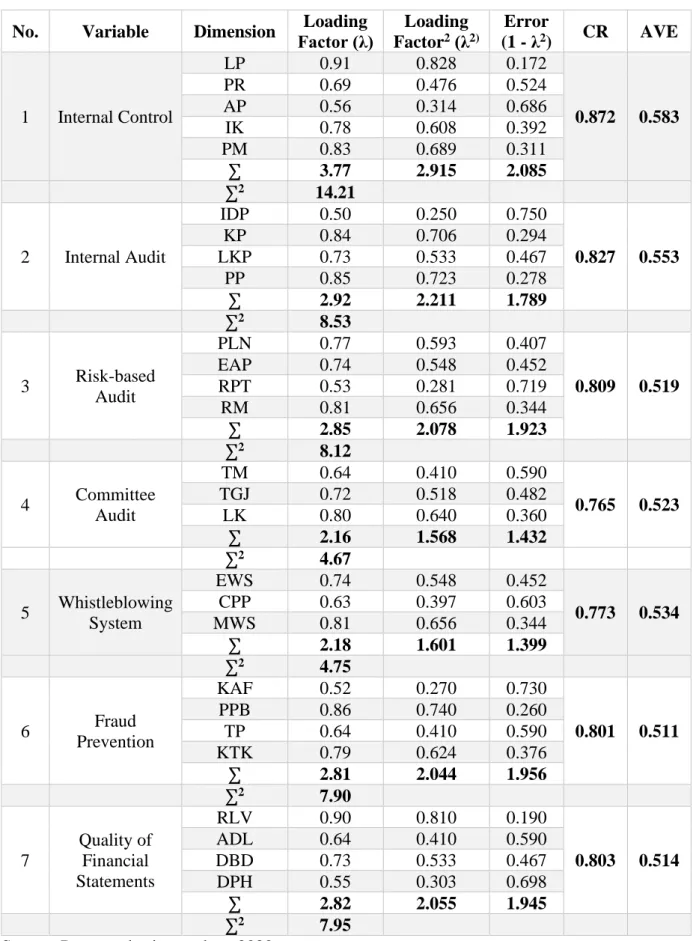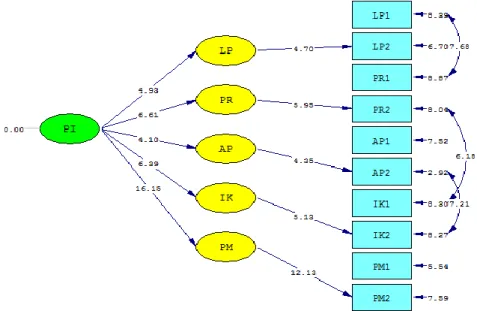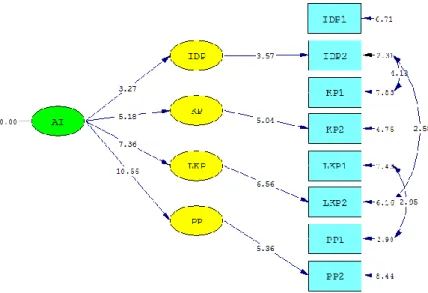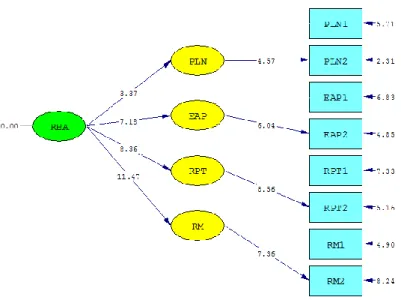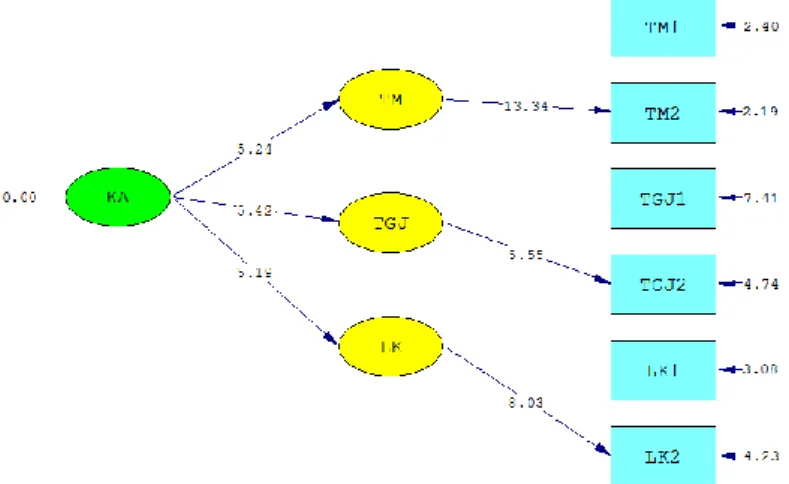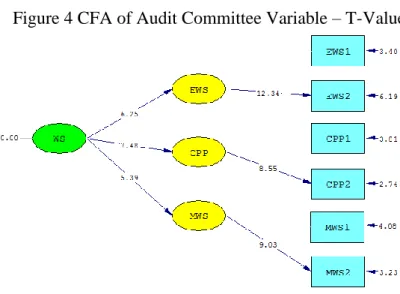The study aims to determine the effect of internal control, internal audit, risk-based audit, audit committee and whistleblowing system on fraud prevention and its implications for the quality of financial statements. But at the same time, the indirect effect of internal control, internal audit, risk-based audit, audit committee, whistleblowing system on the quality of financial statements through the prevention of fraud has a positive and significant effect. The result of Pramudityo's (2017) research found that internal control has a positive effect on the quality of financial statements, but Widyaningtias (2014) found that internal control has a negative and insignificant effect on the quality of financial statements.
However, several results from Widyaningtias (2014) show that internal audit has no effect on the quality of financial statements. Meanwhile, Widyaningtias (2014) states that the internal control system has a negative and insignificant effect on the quality of financial statements. According to research by Pramudityo (2017), the role of internal audit influences the quality of financial statements.
However, research by Widyaningtias (2014) shows that the capacity of internal auditors has a negative and insignificant effect on the quality of financial statements. Meanwhile, Nugrahani (2015) states that the audit committee had no influence on the quality of financial statements. Effect of internal control, internal audit, risk-based audit, audit committee and whistleblowing system at the same time on the quality of financial statements through fraud prevention.
H13: Internal control, internal audit, risk-based audit, audit committee and whistleblowing system have a positive and significant effect on the quality of financial statements through fraud prevention.
RESULT AND DISCUSSION
The construct reliability (CR) value is derived from the square of the total value (sum) of the standard load divided by the square of the total value of the standard load plus the sum error value, then the average variance extracted (AVE) value is derived from the of the sum (total) squared of the standard load divided by the square of the sum of the standard load plus the error value of the sum. 2009) said that the general rules for construct validity are: a) standardized factor loading (SLF) of 0.5 or higher to meet construct validity; b) average variance extracted (AVE) of 0.5 or greater to suggest adequate convergent validity; and c) construct reliability (CR) of 0.7 or higher to indicate adequate convergence or internal consistency. Internal Control with a positive path coefficient of 0.52 has a t-count of 5.83> t-table 1.98, then H1 is accepted, which means that internal control (X1) partially has a positive and significant effect on Fraud Prevention (Y ). The results of this study are consistent with the research of Gusnardi (2011) and research by Maliawan, Sujana, and Diatmika (2017), which found a significant effect of internal control on fraud prevention. The results of this study prove that the higher the internal control, the better the level of fraud prevention.
Risk-based audit with a positive coefficient of 0.47 has a t-number of 4.60> t-table of 1.98, then H3 is accepted, which means that risk-based audit (X3) partially has a positive and significant effect on prevention of fraud ( Y). The Audit Committee with a positive path coefficient of 0.59 has a t-number of 5.32> t-table 1.98, then H4 is accepted, which means that the Audit Committee (X4) partially has a positive and significant effect on Fraud Prevention (Y) . Whistleblowing System with a negative path coefficient of -0.11 has t-number -1.24 Internal control with a positive path coefficient of 0.42 has a t count of 3.65> t table 1.98 then H7 is accepted, which means that internal control (X1) partially has a positive and significant effect on the quality of financial statements (Z ). Internal Audit with a positive path coefficient of 0.56 has a t-count 4.05> t-table 1.98 then H8 is accepted, which means that internal audit (X2) partially has a positive and significant effect on the quality of financial statements ( Z ). The Audit Committee with negative path coefficient -0.18 has a t-count -1.00 Whistleblowing system with a positive path coefficient of 0.68 has a t-score of 6.70> t-table 1.98, then H11 is accepted, which means that the whistleblowing system (X5) partially has a positive and significant effect on the quality of financial statements ( Z) ). Fraud prevention with a positive path coefficient of 0.85 has a t-score of 10.32> t- table 1.98, then H12 is accepted, which means the fraud prevention (Y) partially has a positive and significant effect on the quality of financial statements (Z ) ). Next, for the F-test (presented in Table 8), H6 has an F-score value of 111.352> F-table of 2.28 then H6 is accepted, which means internal control, internal audit, risk-based audit, audit committee, and whistle-blowing system has both a positive and significant effect on the prevention of fraud. Then for H13 there is an F-count value of 181.829> F-table of 2.28, then H13 is accepted, which means that internal control, internal audit, risk-based audit, audit committee and whistleblowing system have simultaneously a positive and significant effect on the quality of financial statements through the prevention of fraud. From Table 8, the effect of internal control (X1), internal audit (X2), risk-based audit (X3), audit committee (X4) and whistleblowing system (X5) simultaneously on fraud prevention (Y) have a coefficient of determination of 0.79. Moreover, the effect of internal control (X1), internal audit (X2), risk-based audit (X3), audit committee (X4) and whistleblowing system (X5) simultaneously on the quality of financial statements (Z ) through fraud prevention (Y) have a coefficient of determination of 0.86. The positive and significant results show that the existence of anti-fraud measures can increase the legitimacy of companies' financial statements, according to Lou & Wang (2009). Establishing fraud prevention policies and procedures can help management provide appropriate assurance in the financial statements. This means that the ability of these independent variables to explain fraud prevention is 79%, while the remaining 21% can be explained by other variables from this study. This means that the ability of these independent variables to explain the quality of accounts through fraud prevention is 86%, while the remaining 14% can be explained by other variables from this study. This can happen because not many companies have implemented a risk-based audit approach in their business units. In addition, the audit committee partially has a negative and insignificant effect on the quality of the accounts. The results of this study are consistent with the study of Nugrahani (2015), which stated that the audit committee has no influence on the quality of the financial statements, but is different from that of Mwangi et al. 2017) and Okpala (2012) , which stated that the audit committee influences the quality of the annual accounts. Moreover, the whistleblowing system and fraud prevention partly have a positive and significant effect on the quality of the annual accounts. In the whistleblowing system, there are mechanisms for providing important information, early detection and focus on corrective action to produce reliable financial statements. Fraud prevention has also been proven to improve the quality of financial statements, consistent with research by Lou & Wang (2009). However, at the same time, the indirect effect of internal control, internal audit, risk-based audit, audit committee, whistleblowing system on the quality of financial statements through fraud prevention (as an intervening variable) has a positive effect and significant. For scientific development, it is hoped that it can increase the knowledge of the factors that influence fraud and the quality of financial statements. Moreover, it also supports the development process of these factors, and makes it easier to identify 'red flags' to detect fraud in companies, so that the resulting financial reports are more reliable. For the company's management, it is hoped that the company will further improve its internal supervision and control system to prevent and reduce fraud committed by certain parties, both from within and outside the company. In the future, the company will pay more attention to the quality of internal control, internal auditors, risk-based audit approaches, audit committees and whistleblowing systems to improve fraud prevention so that the company's objectives can be achieved. Hasil penelitian ini diharapkan dapat memberikan kontribusi dan implikasi bagi pihak-pihak yang berkepentingan. Analisis kualitatif penerapan risk-based auditing dalam penyusunan rencana audit perwakilan BPKP di provinsi Lampung. Pengaruh peran komite audit, pengendalian internal, audit internal dan penerapan tata kelola perusahaan terhadap pencegahan kecurangan. Pengaruh audit internal dan efektivitas pengendalian internal serta efektivitas pengendalian internal terhadap pencegahan kecurangan. Pengaruh keberagaman komite audit terhadap kualitas pelaporan keuangan pada perusahaan milik negara non-komersial di Kenya. Pengaruh kemauan auditor dan manajemen risiko terhadap tata kelola perusahaan menggunakan variabel mediator audit berbasis risiko. Akuntansi keuangan daerah, sistem pengendalian internal dan peran audit internal terhadap kualitas laporan keuangan pemerintah daerah (disertasi). Pengaruh Budaya Organisasi, Audit Fraud Proaktif dan Whistleblowing Terhadap Pencegahan Fraud Dalam Pengelolaan Dana BOS. Pengaruh sistem pengendalian internal, pemanfaatan teknologi informasi dan kapasitas auditor internal terhadap kualitas laporan keuangan BPR Syariah se-Jabodetabek (disertasi). Control environment Information and Communication Independence - Free, honest and objective Planning - Determination of targets and proper focus Purpose and benefits of the Effectiveness of the application Determination of anti-fraud Comparable - Can be compared with the previous year Standard Variable Item Mean Deviation Standard No. Variable Indicator Loading Factor (λ) Error Factor (λ) Goodness of Fit Cut off Value Model Results Criteria H13 accepted Source: The results of data processing with Lisrel 8.8 SEKOLAH TINGGI ILMU EKONOMI Y.A.I,CONCLUSION
COSO, 2013)
SURAT TUGAS
